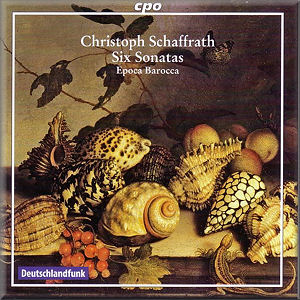 |
 |
|


alternatively
CD: AmazonUK
AmazonUS
|
Christoph SCHAFFRATH (1709
- 1763)
Six Sonatas:-
Duetto for bassoon and harpsichord in f minor [12:46]
Duetto for 2 viole da gamba in d minor [14:05]
Duetto for violin and harpsichord in b flat minor [11:20]
Duetto for 2 harpsichords in C* [13:41]
Duetto for oboe and harpsichord in B flat [13:39]
Duetto for bassoon and harpsichord in g minor [11:22]
 Epoca Barocca (Alessandro Piqué (oboe), Sergio Azzolini (bassoon),
Margarete Adorf (violin), Hartwig Groth, Jan Freiheit (viola da
gamba), Christoph Lehmann, Christoph Alselm Noll* (harpsichord))
Epoca Barocca (Alessandro Piqué (oboe), Sergio Azzolini (bassoon),
Margarete Adorf (violin), Hartwig Groth, Jan Freiheit (viola da
gamba), Christoph Lehmann, Christoph Alselm Noll* (harpsichord))
rec. October 2003, October 2005, December 2007, chamber music room,
Deutschlandfunk, Cologne, Germany. DDD
 CPO 777 440-2 [77:18]
CPO 777 440-2 [77:18] 
|
|
|
Christoph Schaffrath was one of a group of composers who played an important role in the musical life of Berlin, at and around the court of Frederick the Great. Not much is known about Schaffrath before the 1730s. He was born in Hohenstein, but whether he came from a musical family or who his first teacher was is not known. In 1733 he applied for the position of organist at the Sophienkirche in Dresden, but was rejected – Wilhelm Friedemann Bach secured the post instead. The next year he entered the service of Frederick the Great, who was still Crown-Prince at that time. Frederick started his own chapel in Ruppin, which moved to Rheinsberg in 1736. With his accession to the throne in 1740 Schaffrath became harpsichordist in his chapel. But in 1741 he entered the service of Frederick's sister Anna Amalia. It seems this resulted in Schaffrath leaving the court, as his name does not appear in a list of musicians of the chapel from 1754.
Anna Amalia's taste in music was rather conservative. She preferred the traditional German contrapuntal style over the modern fashion of her days which gave prominence to melody. Whether Schaffrath adapted his style of composing to her taste or the music on this disc is an expression of his own preferences is difficult to say. In Epoca Barocca's previous recording of music by Schaffrath (CPO 777 116-2) we hear music which is partly written in a more galant idiom. That is also the case with the six sonatas for keyboard opus 2 (recorded by Borbála Dobozy - Hungaroton HCD 32566). But on the other hand Ernst Ludwig Gerber, a writer of a lexicon on music, wrote that Schaffrath was "one of our most worthy contrapuntalists".
Anyway, the sonatas which Epoca Barocca has recorded reflect the preferences of his employer. They stick to the baroque form of the trio sonata, although they are all written for two instruments. Of the six duets four are for obbligato harpsichord and a melody instrument. This kind of composition was first written by Johann Sebastian Bach, for keyboard with violin, transverse flute or viola da gamba. His son Carl Philipp Emanuel also composed pieces of this kind.
The harpsichord usually takes the lead and starts most movements, with the violin, oboe or bassoon entering after a while, beginning by imitating the opening theme of the keyboard. Although these duets have conservative traits there are certainly modern elements. All are written in three movements, with the order slow-fast-fast, and they contain imitative passages as well as episodes in which the melody instrument plays in parallel motion with the upper voice of the harpsichord. Also reflecting the fashion of the time is the repetition of notes in the harpsichord, particularly in the second movement (allegro assai) of the Duetto in g minor.
It is very likely that the keyboard parts of these duets were to be played by Christoph Schaffrath himself and therefore reflect his own brilliance as a keyboard player. In the liner-notes it is suggested that the second keyboard in the Duetto in C could have been written for Anna Amalia, who was a very good keyboard player herself. In this duet episodes for one of the keyboards alternate with passages in which the harpsichords join each other. But the duet never gets an 'orchestral' character, because when the harpsichords play together their bass parts are identical. This assures a great amount of transparency.
A special kind of duet is the Duetto in d minor for two viole da gamba. There is no doubt that it was written for Ludwig Christian Hesse (1716 - 1772), who was the most skilled gambist in Germany at a time when in most parts of Europe the viola da gamba was on its way out of the music scene. This particular duet suggests that Hesse was sometimes actively involved in the composition of music for his instrument. The two parts have different staves, one of them written by Hesse - it includes detailed articulations - and the other by Schaffrath. It is a very nice piece with two parts of a quite different character.
Epoca Barocca has a special preference for lesser-known repertoire. They have recorded chamber music by composers like Johann Friedrich Fasch, Johann Adolf Hasse, Johann David Heinichen and Giovanni Benedetti Platti. I have heard them all, and in my reviews I have always recommended them. This disc is no exception. Epoca Barocca delivers vivid and imaginative performances, and Christoph Lehmann is particularly impressive in his brilliant performance of the demanding keyboard parts. Christoph Anselm Noll is his congenial partner on the second harpsichord in the Duetto in C. Hartwig Groth and Jan Freiheit deliver an engaging interpretation of the duet for two viole da gamba.
This is a highly enjoyable disc with first-rate music in fine performances.
Johan van Veen
|
|

